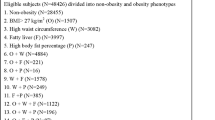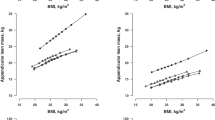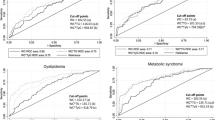Abstract
Objective:
To compare the association of obesity and abdominal obesity with cardiometabolic risk factor burden and global estimated coronary heart disease (CHD) risk among multiethnic US adults.
Design:
Cross-sectional, survey study.
Subjects:
A total of 4456 participants (representing 194.9 million adults) aged 20–79 years in the 2003–2004 National Health and Nutrition Examination Survey (NHANES).
Measurements:
Body mass index (BMI) and waist circumference (WC) measures, CHD risk factors and a 10-year estimated CHD risk based on Framingham algorithms. Obesity was defined as a BMI ⩾30 kg/m2 and abdominal obesity as a WC >88 cm in women and >102 cm in men. High CHD risk status included diabetes, cardiovascular disease (CVD) or a 10-year Framingham risk score of >20%.
Results:
Overall, abdominal obesity was present in 42.3% of men and 62.5% of women and in 53.6% of whites, 56.9% of blacks and 50.5% of Hispanics (P<0.001 between gender and ethnicity). However, using International Diabetes Federation (IDF)-recommended WC cut points for Hispanics, the prevalence of abdominal obesity was 78.3%. Mean levels of low-density lipoprotein cholesterol (LDL-C), systolic and diastolic blood pressure, fasting glucose and C-reactive protein increased, and high-density lipoprotein cholesterol (HDL-C) decreased (P<0.001) according to BMI and WC categories, although these associations were attenuated in blacks for blood pressure, LDL-C, HDL-C and triglycerides. Of those with high WC, 25–35% had ⩾3 cardiometabolic risk factors. High CHD risk among those with high WC was most common in men (27.9%) and non-Hispanic whites (23.9%). Persons with a high vs normal WC, adjusted for age, gender, ethnicity and BMI were more likely to have ⩾3 cardiometabolic risk factors (odds ratio (OR)=5.1, 95% confidence interval (CI)=3.9–6.6) and were classified as high CHD risk (OR=1.5, 95% CI=1.1–2.0).
Conclusion:
The association of abdominal obesity with risk factors varies by ethnicity and is independently associated with high CHD risk status, further validating its clinical significance.
This is a preview of subscription content, access via your institution
Access options
Subscribe to this journal
Receive 12 print issues and online access
$259.00 per year
only $21.58 per issue
Buy this article
- Purchase on Springer Link
- Instant access to full article PDF
Prices may be subject to local taxes which are calculated during checkout





Similar content being viewed by others
References
McCowen KC, Blackburn GL . Obesity and weight control. In: Wong ND, Black HR, Gardin JM (eds). Preventive Cardiology. McGraw Hill: New York, 2005, pp 233–255.
National Institutes of Health. Clinical guidelines on the identification, evaluation, and treatment of overweight and obesity in adults—the evidence report. Obesity Res 1998; 6 (Suppl 2): 51S–209S.
Li C, Ford ES, McGuire LC, Mokdad AH . Increasing trends in waist circumference and abdominal obesity among US adults. Obesity 2007; 15: 216–224.
Alberti KG, Zimmet P, Shaw J . Metabolic syndrome—a new world-wide definition. A Consensus Statement from the International Diabetes Federation. Diabet Med 2006; 23: 469–480.
NHANES 1999–2000 Laboratory/Medical Technologists Procedures Manual.
Pearson TA, Mensah GA, Alexander RW, Anderson JL, Cannon III RO, Criqui M et al. AHA/CDC scientific statement: markers of inflammation and cardiovascular disease: application to clinical and public health practice. A statement for healthcare professionals from the Centers for Disease Control and Prevention and the American Heart Association. Circulation 2003; 107: 499–511.
Expert Panel on Detection, Evaluation, and Treatment of High Blood Cholesterol in Adults. Executive Summary of the Third Report of the National Cholesterol Education Program (NCEP) Expert Panel on Detection, Evaluation, and Treatment of High Blood Cholesterol in Adults (Adult Treatment Panel III). JAMA 2001; 285: 2486–2497.
Mosca L, for the Expert Panel/Writing Group. Summary of the American Heart Association's Evidence-Based Guidelines for Cardiovascular Disease Prevention in Women. Arterioscler Thromb Vasc Biol 2004; 24: 394–396.
Shah BV, Barnwell BG, Bieler GS . SUDAAN USERS’ Manual, release 7.5. Research Triangle Institute: Cary, NC, 1997.
SAS Procedures Guide. version 6.12. 3rd edn SAS Institute: Cary, NC, 1995.
Reeder BA, Senthilsevan A, Despres JP, Angel A, Liu L, Wang H et al. The association of cardiovascular disease risk factors with abdominal obesity in Canada. Canadian Heart Health Surveys Research Group. CMAJ 1997; 157 (Suppl 1): S39–S45.
Fox CS, Massaro JM, Hoffmann U, Pou KM, Maurovich-Horvat P, Liu CY et al. Abdominal visceral and subcutaneous adipose tissue compartments: association with metabolic risk factors in the Framingham Heart Study. Circulation 2007; 116: 39–48.
Lee CD, Jacobs Jr DR, Schreiner PJ, Iribarren C, Hankinson A . Abdominal obesity and coronary artery calcification in young adults: the Coronary Artery Risk Devleopment in Young Adults (CARDIA) Study. Am J Clin Nutr 2007; 86: 48–54.
Lakka HM, Lakka TA, Tuomilehto J, Salonen JT . Abdominal obesity is associated with increased risk of acute coronary event sin men. Eur Heart J 2002; 23: 706–713.
Batty GD, Shipley MJ, Jarrett RJ, Breeze E, Marmot MG, Davey Smith G . Obesity and overweight in relation to disease-specific mortality in men with and without existing coronary heart disease in London: the original Whitehall study. Heart 2006; 92: 886–892.
Adams KF, Schatzkin A, Harris TB, Kipnis V, Mouw T, Ballard-Barbash R et al. Overweight, obesity, and mortality in a large prospective cohort of persons 50–71 years old. N Engl J Med 2006; 355: 763–778.
Flegal KM, Graubard BI, Williamson DF, Gail MH . Cause-specific excess deaths associated with underweight, overweight, and obesity. JAMA 2007; 298: 2028–2037.
Acknowledgements
This study was supported by a contract from Merck & Co. Inc. to the University of California, Irvine. Dr Wong has received research funding from Merck & Co. Inc. and Pfizer Inc. through the University of California, Irvine and has served as a consultant for Merck & Co. Inc. and Novartis, and is on the speaker's bureau for Takeda Pharmaceuticals. Dr Sachin Kamal-Bahl is an employee with Merck & Co. Inc.
Author information
Authors and Affiliations
Corresponding author
Rights and permissions
About this article
Cite this article
Ghandehari, H., Le, V., Kamal-Bahl, S. et al. Abdominal obesity and the spectrum of global cardiometabolic risks in US adults. Int J Obes 33, 239–248 (2009). https://doi.org/10.1038/ijo.2008.252
Received:
Revised:
Accepted:
Published:
Issue Date:
DOI: https://doi.org/10.1038/ijo.2008.252
Keywords
This article is cited by
-
Common Medications Which Lead to Unintended Alterations in Weight Gain or Organ Lipotoxicity
Current Gastroenterology Reports (2016)
-
Abdominal Obesity, Body Mass Index, and Hypertension in US Adults: NHANES 2007–2010
American Journal of Hypertension (2012)
-
Renal function and severity of bright liver. Relationship with insulin resistance, intrarenal resistive index, and glomerular filtration rate
Hepatology International (2011)
-
Does Self-Reported Physical Activity Underestimate the Importance of Activity in Cardiovascular Disease Prevention?
Current Cardiovascular Risk Reports (2010)
-
Coronary Heart Disease and Body Fat Distribution
Current Atherosclerosis Reports (2010)



